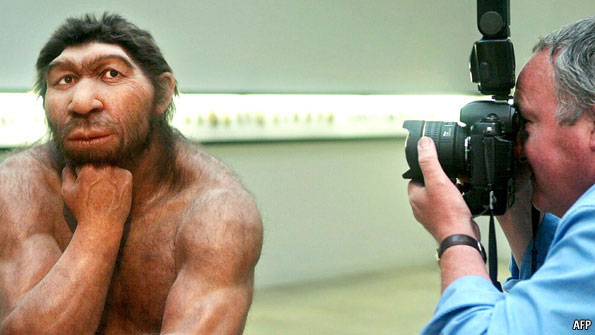The Neanderthal genome
A cave man blinking in the light
The DNA of modern humanity’s closest extinct relative is undergoing detailed analysis
KNOW thyself” was the admonition over the entrance to the oracle at Delphi. Good advice, but hard to follow unless you have points of comparison with others from which to derive such knowledge. That is one reason why the uniqueness of Homo sapiens is difficult to fathom. The evolutionary processes that have made people so different from other animals are hard to determine without an ability to examine human species that have not, in the words of Douglas Adams, achieved “New York, wars and so on”. In a scientific tour de force, however, Svante Paabo of the Max Planck Institute for Evolutionary Anthropology in Leipzig and his colleagues have made such a comparison possible. They have published, in this week’s Science, an analysis of the genome of Neanderthal man.
Homo neanderthalensis, to give its proper name, lived in Europe and parts of Asia from 400,000 years ago to 30,000 years ago. Towards the end of this period it shared its range with interlopers in the form of Homo sapiens, which was spreading out from Africa, but the two species did not settle down to a stable cohabitation. For reasons which are yet unknown, the arrival of Homo sapiens in a region was always quickly followed by the disappearance of Neanderthals.
Dr Paabo had announced that he had the Neanderthal genome in February 2009, at a meeting of the American Association for the Advancement of Science. At that time, however, his team had conducted only a superficial comparison between the DNA of Neanderthals and modern humans. Now they have performed a more thorough study, and in doing so have shed a fascinating light on the intertwined history of the two species.
Kissing cousins
That history turns out to be more intertwined than many had previously believed. Dr Paabo and his colleagues compared their Neanderthal genome (painstakingly reconstructed from three bone samples collected from a cave in Croatia) with that of five living humans from various parts of Africa and Eurasia. Previous genetic analysis, which examined DNA passed from mother to child in cellular structures called mitochondria, had suggested no interbreeding between Neanderthals and modern humans. The new, more extensive examination, which looks at DNA in the cell nucleus, shows this conclusion is wrong. By comparing the DNA of Africans (whose ancestors could not have crossbred with Neanderthals, since they did not overlap with them) and various Eurasians (whose ancestors could have crossbred with Neanderthals), Dr Paabo has shown that Eurasians are between 1% and 4% Neanderthal.
That is intriguing. It shows that even after several hundred thousand years of separation, the two species were interfertile. It is curious, though, that no Neanderthal mitochondrial DNA has turned up in modern humans, since the usual pattern of invasion, in historical times anyway, is for the invaders’ males to mate with the invaded’s females.
One piece of self-knowledge, then—at least for non-Africans—is that they have a dash of Neanderthal in them. But Dr Paabo’s work also illuminates the differences between the species. By comparing modern humans, Neanderthals and chimpanzees it is possible to distinguish genetic changes shared by several species of human in their evolution away from the great-ape lineage from those that are unique to Homo sapiens.
More than 90% of the “human accelerated regions” that have been identified in modern people are found in Neanderthals, too. But the rest are not. Dr Paabo has identified 212 parts of the genome that seem to have undergone significant evolution since the species split. The state of genome science is still quite primitive, and it is often unclear what any given bit of DNA is actually doing. But an examination of the 20 largest regions that have evolved in this way shows that they include several genes associated with cognitive ability—and whose malfunction causes serious mental problems. The presence of an extra copy of DYRK1A is linked to Down’s syndrome; mutation of NRG3 is linked to schizophrenia; mutations of CADPS2 and AUTS2 are linked to autism. These four genes therefore look like good places to start the search for modern humanity’s essence.
The newly evolved regions also include a gene called RUNX2, which controls bone growth. That may account for differences in the shape of the skull and the rib cage between the two species. By contrast an earlier phase of the study had already shown that Neanderthals and moderns share the same version of a gene called FOXP2, which is involved in the ability to speak and which differs in chimpanzees. It is all, then, very promising—and a second coup in quick succession for Dr Paabo. In March another of his teams revealed the existence of a hitherto unsuspected species of human using mitochondrial DNA found in a little-finger bone. If that species, too, could have its full genome read, humanity’s ability to know itself would be enhanced even further.
